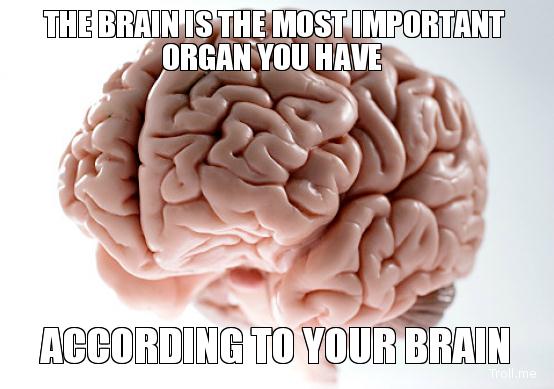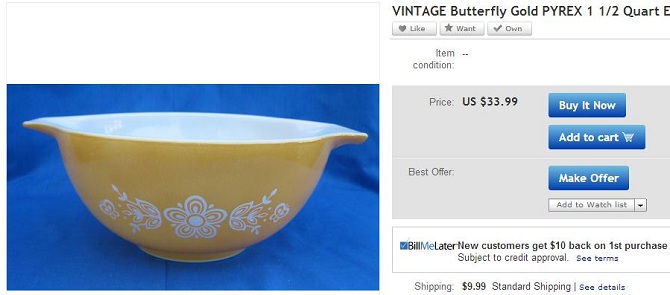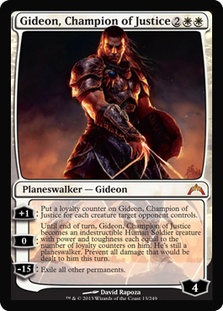Your brain thinks that it can do anything.
I mean, obviously there are things you are better at than other things. You probably excelled in some subjects at school and struggled with others. When it comes down to it, though, your brain is pretty sure that it understands how to make sense of the world and make smart, accurate decisions. It believes that whatever biases it has are there with good reason.
But is that really the case?

Lucky for us, scientists have been able to identify how the brain makes dubious decisions that we aren’t even conscious of. These are known as cognitive biases, and they represent individual choices that often work against our own self-interest. Often, these choices are imperceptible until later on when you realize you did something that you didn’t really want to do and you’re not sure why it seemed right at the time.
Unsurprisingly, many of these biases come into play when making decisions about money. All of them are well known to retailers, and you will often encounter marketing campaigns or sales pitches designed to take advantage of them. Because there is little difference between the world of retail sales and the world of Magic trading and speculation, most of these cognitive biases affect our business as well.
In this article, I will cover several of the most important cognitive biases and how to overcome them. Unfortunately, most of these biases are innate—even if you understand how they work, you will still be susceptible to their sway. Even still, it is important to try. If this article helps you avoid even one bad decision, the time you spent reading it was likely worth it.
It’s also important to note that these biases aren’t necessarily bad. It would be nice to think that all deals are made in a Faraday cage of perfect reason and rationality, but that is never what actually happens. Most trades have an irrational aspect to them, and often a trading partner who has a card you really want will approach a deal from a position that makes completing a trade very difficult (out of date prices, unreasonable demands about condition, etc.). In these cases, knowledge of these cognitive biases may help you make a deal that otherwise wouldn’t get done. While I don’t suggest or condone lying to anyone or misrepresenting your cards in any way, using knowledge of how people mentally approach a deal in your favor is just good salesmanship.
Anchoring Bias
Pretend you are at a yard sale. The proprietor is a middle-aged woman who is selling the contents of her late mother’s storage unit. Many of the items haven’t seen the light of day for twenty or thirty years at least. The sale is full of pickers, and items are going fast. You grab a box that contains, appropriately named for this exercise, a set of Anchor Hocking mixing bowls:

Quick—what are the bowls worth?
With no information available, guesses made by readers of this column are going to be all over the place. I’d be willing to bet that the margin between the lowest and highest guess will be astronomical. After all, they are going to be based on each person’s separate—and likely very limited—experience with pricing vintage mixing bowls.
But what if I provided you with another piece of tangentially related information? For example, check out this current listing on eBay:

This mixing bowl is made by a different manufacturer. It is of a different vintage. It is a different style. It is a single bowl, not a complete set. The value—$33.99 plus shipping—isn’t even a completed sale; it’s just an asking price. The value of this mixing bowl is almost entirely unrelated to that of the Anchor Hocking collection above.
Yet the price of this bowl has likely affected your opinion on the other collection of glassware. If I had given all of you this piece of information first before asking you what your guess is on the Anchor Hocking set, the range of guesses I’d get would likely be far narrower.
This is due to a cognitive bias called anchoring. When evaluating the value of an item, humans tend to focus far too much on the first piece of information given at the expense of other knowledge. This first “anchor” price will prevent you from objectively analyzing the price of other, similar items for sale. (The tulip bowl set, by the way, sold on eBay for $400.)
This phenomenon happens a lot in Magic pricing.
For example, the first price we see a card for sale at—the initial preorder price—acts as an anchor. Because of that, it can take a while for a card to move out of a certain value range. Take Vraska, the Unseen. She started preordering at $40 and stayed there until the second week of October. Then she dropped all the way to $25 before finally crawling down to $10. Even though Vraska never saw any play, she was anchored by her initial price and didn’t hit $10—the price point of a “bulk mythic planeswalker”—until the first of December.
On the other hand, it can take a while for a low value card to ever jump in price, even while seeing a good amount of play. For example, Runechanter’s Pike was a large part of Standard last year, but aside for a few small spikes at individual events, the card never went above $1-$2. Some of this is the standard market forces of supply and demand, but anchoring is a part of it as well.
Anchoring comes up a lot in negotiations too. In general, the first price thrown out in a negotiation acts as the anchor for the eventual sale. This is why used car lots always start their negotiations at a value much higher than the price they expect to close at. By setting the anchor price, they can work from a position of maximum leverage.
This can happen in Magic trading as well. Have you ever come across someone who has proposed a trade glaringly obvious in their favor, only to laugh it off and then attempt to deal with you in a relatively fair manner? Chances are they were trying to exploit their knowledge of this cognitive bias based on anecdotal results. Even if you aren’t consciously aware of this shift in perspective happening, you will be weighing your eventual trade against that offer and may end up making a deal you otherwise wouldn’t.
Interestingly, studies have shown that specificity is important to anchoring as well. If the anchor price is a nice, round number—let’s use $20 as an example—the negotiations will likely take place in larger strokes. The haggling in that case might settle on a price between $15 and $18. If, however, the initial anchor is more specific—$19.90, for example—the negotiations will stay much, much closer to that initial figure.
This last point is wildly helpful when trying to complete a trade. If there is a deal you don’t want to haggle too much on, make sure you include several small value cards on at least one side of the deal. These throw ins are the Magic equivalent of nickels and dimes, and they can add specificity to your trade that will keep the anchor price close to the deal you want to go through.
The Decoy Effect
The decoy effect is a close cousin of anchoring bias, and it is something that electronics manufacturers have used for years now.
Let’s pretend that you are looking to buy a brand new television. You have two choices: a 32-inch set for $400 or a 38-inch set for $500. In this case, the size of the TV you buy largely depends on how much you value your money versus how important a larger screen size is to you. Some of you would buy the first set, and some of you would buy the second.
Now let’s add a third TV to the product line. This TV is 36 inches wide and costs $550.
Who would buy this TV? Almost no one. It may have a few extra features added to justify the increased price, but by and large it is dramatically inferior to the two other options. The only reason this TV exists is to make consumers far more likely to buy the $500 TV. That is because when comparing that set side-by-side with the other two options, it seems like the best possible deal. Your brain will tell you that it provides the best overall value, and you will end up walking out of the store paying $100 more than you otherwise might have because of a product that you never would have bought in the first place.
The decoy effect can also be used in conjunction with anchoring to sell items that never would have moved in the first place. There’s a famous story in the marketing world about how Williams-Sonoma was able to use this cognitive bias in order to jumpstart sales on a bread maker that no one was buying. They had the retail price set at $275, and customers just weren’t interested.
In an effort to increase sales, they released a second bread maker. This one was slightly larger and cost a whopping $400. Even though the larger machine never sold, it was the perfect way to help get the smaller bread maker to start flying off the shelves. Compared to the $400 anchor point, even though it was just a decoy, the $275 bread maker seemed like a sweet deal.
This trick doesn’t work all that well in Magic trading. You can’t really have a ‘decoy’ Thoughtseize, and most card prices are based on playability and demand. This does come up, however, when dealing with high-end foils, foreign cards, and other rarities.
The decoy effect is likely the reason many people keep power, Beta dual lands, or other expensive cards in the first few pages of their binder. Next to these cards, the stuff that you can actually trade for seems that much more desirable.
This happens most often in those small four-pocket binders that many higher-end traders carry around. Like it or not, you’ll be holding a set of Glacial Fortresses in much higher esteem when they’re nestled in between a set of Tundras and a set of Flooded Strands. Even if you weren’t planning to trade for the duals or fetches, you will likely be willing to give up more for the M10 lands based solely on their proximity to those other cards than if you had found them in a binder filled with other random Standard stuff. The same is true for casual foils and misprints—everything seems like a better deal when directly compared to something that feels overly expensive.
Confirmation Bias and The Backfire Effect
Where do you get your news?
These days, it is nearly impossible to avoid having a bias in the world of politics and current events. While some non-partisan news sources exist—The BBC, NPR, and CNN are among the best—almost all of the websites I visit for news are written for people who already agree with me by people who already agree with me. As a liberal, I get much of my news from various left-leaning sources posted to Reddit—articles published by The Atlantic, The New Yorker, Politico, and Think Progress, as well as TV programs like The Daily Show. The people I follow on Twitter are also overwhelmingly liberal, so the discourse I am exposed to on a daily basis is almost always left of center.
Whatever your political bent is, my guess is that you live in an equally provincial world. There are equivalent echo chambers for fiscal conservatives, social conservatives, and libertarians, too.
If you are the sort of person who avoids news and politics like the plague, consider another area where you have an obvious bias. Are you an avid fan of a particular sports team? A vegan or vegetarian? A sci-fi or fantasy movie junkie? Do you have a strong opinion about which video game platform is better or which genre of music you prefer? Are you a Mac or PC fan? IPhone or Android?
Humans, it turns out, are terrible at basing their opinions on objective analysis. Instead, confirmation bias tells us that we form our beliefs based on what we choose to pay attention to. And, for the most part, we only pay attention to the stuff we already agree with while ignoring or dismissing the stuff we disagree with.
The Backfire Effect is even crazier. Not only do we constantly reconfirm our beliefs based on a selective reading of data, but exposure to evidence disproving our beliefs is met with resistance and entrenchment. That’s right—if you believe something and are given evidence that contradicts it, your original belief in that idea only grows stronger!
Confirmation bias probably didn’t matter all that much back when humans were exposed to very little information. In fact, anecdotal information about proper pig farming was likely more useful than a “hot tip” from the peasant across town who had this totally awesome secret about the best kind of mud. Even back in the pre-Internet days, most of us didn’t really have a choice about where to get our information.
Now, though, we have a nearly infinite number of sources from which to gather information. It’s no shock that our society is so polarized—we’re living in parallel worlds that just happen to occupy the same physical realm.
At any rate, confirmation bias is extremely problematic when it comes to Magic speculation. Take, for example, Gideon, Champion of Justice.
From the second he was spoiled, players lined up on either side of the divide in order to express their opinions about him. Everyone’s opinion shared only one thing in common: no one was lukewarm on the brand new planeswalker. Roughly half of my Twitter feed thought Gideon was absolutely bananas, and the other half thought he was garbage. There was no in between.
People are divided about Gideon because we all base our card evaluations on individual experiences. Players who used the original Gideon a lot might feel more strongly about the new one than those who didn’t. Beyond that, people have different individual experiences with planeswalkers in general. Someone who preordered Jace, the Mind Sculptor and played with it for two straight years is coming from a different place than someone who preordered Tibalt, the Fiend-Blooded and had to quickly scramble for a new deck. People might even be biased because they always play with white cards, or they don’t play control, or they think the art is awesome or terrible.
Granted, some people are just objectively good at card evaluation and are going to end up being correct about Gideon. The problem is that the other people who get it right are going to have their opinion reinforced, even if they used a faulty method to reach that conclusion. And, as we know by studying the backfire effect, the people who get it wrong are likely to ignore the missed call anyway.
Another problem is that it’s far too easy to lose objectivity once you have made a speculative purchase. Have you ever gambled on a sporting event that you otherwise had no rooting interest in just to make watching it more interesting? Speculating on a card isn’t much different. A few weeks ago, I read several cases for and against going in on Master of the Pearl Trident as a spec opportunity ahead of the Merfolk that we knew would show up in Gatecrash. Ultimately, I decided to buy in. From that moment on, I was on Team Merfolk. I would excitedly read about theoretical decks that could use the card while rolling my eyes at people who said it would never amount to anything. I had become a Master of the Pearl Trident partisan.
This is especially dangerous for writers because our number one goal is to provide you with unbiased analysis. If I were to let my own speculation attempts color what I write in this column, I would be doing all of you an extreme disservice. This is why I struggle to stay objective, rarely speculate anymore, and why I always immediately disclose my specs on Twitter when I make them.
This bias is dangerous for all of you as well. If you only read half the story about a card, you may well miss out on the right time to sell and lock in maximum value. It might also begin to color your opinion about the metagame as a whole, tricking you into bringing the wrong deck to your next big event. It may also impact your next speculation decision, allowing anecdotal evidence to overpower rationality when deciding whether or not to go in on a similar card in a few months.
It’s not all bad, though. In fact, confirmation bias can be a major boon to traders.
Because this phenomenon is inescapable, we all have certain cards that we are biased against and cards we are biased toward. Occasionally, someone can be biased towards or against an entire strategy or format. If you can force yourself to be as objective as possible, you can use this to your advantage by trading someone a card they strongly favor for a better card they strongly dislike. This gives you the opportunity to make a profitable trade that your partner is thrilled with: a true win/win.
The important thing isn’t to stop being biased—after all, life has right and wrong answers, so your personal bias may in fact be the correct one. The key thing is being able to recognize when that bias is preventing you from making an objectively better decision. When in doubt, remember to make sure you are using all of the information at your disposal, not just the stuff that you agree with.
Gatecrash Spoilers So Far
I am writing this on the afternoon of Wednesday, January 2nd, and I will weigh in on cards that have been spoiled since then next week. As of now, the two cards in the set I like the most are Obzedat, Ghost Council and Whispering Madness.
Obzedat is one of the best creatures ever printed and will likely be one of the pillars of Standard over the next two years. I missed the chance to preorder him at $15, and if he is relisted at that price I will buy in. I expect the card to fluctuate between $20 and $40 while Standard legal and see a similar amount of play to Geist of Saint Traft, Sphinx’s Revelation, Thundermaw Hellkite, Falkenrath Aristocrat, and the other tier 1 mythics.
Whispering Madness compares favorably to Windfall, a card banned in Legacy and restricted in Vintage. Granted, it is best in the type of fast combo deck that doesn’t seem to exist in Standard anymore, but I feel as though cipher is being underrated and the ability is objectively strong enough that it will see play. Sometimes, the first card spoiled to showcase an ability will be underrated for a while as people’s mouths water over what sexier card is just around the spoiler corner. I believe that is what is going on here. I picked up a couple sets at the preorder price of $1.50 and feel like that is a safe, low-risk bet. Also, remember to pick up Invisible Stalkers when you can. It’s already up to $2 based on cipher speculation.
Until next week–
–Chas Andres

